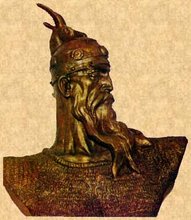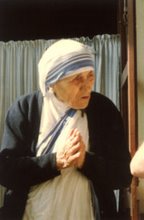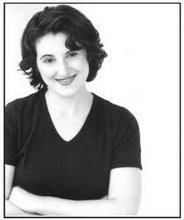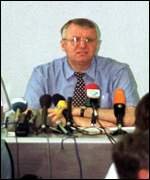
Witnesses identified the man on the right as Nebojsa Minic, known as "Mrtvi" ("Death"). He is implicated in the extortion and killing of six family members in Pec on June 12. On the left is Vidomir Salipur, a Pec policeman and alleged head of the Munja gang, who was killed by the KLA on April 8, 1999. The date and location of the photograph are unknown. © Human Rights Watch
From Daily Telegraph (UK), Sunday 29 June, 1999
My name is Death...'
By Philip Sherwell in Pec
THE Serbian retreat from Pec was already underway,
Italian peacekeeping troops were en route from
Macedonia. At last, the Bala family thought, their
ordeal was finally over. They had survived 80 days
behind the shutters of their home while Slobodan
Milosevic's forces terrorised the city known as the
"Serb Jerusalem".
They were terribly wrong. For Isa Bala, the true horror
began only after the Yugoslav president agreed to pull
his men out of Kosovo. Last Saturday night his home
became a bloodbath: seven members of his family were
shot within its walls.
A band of Serbian paramilitaries led by a local thug who
revelled in the nickname "Mrtvi" (Death) went on a final
rampage of killing, raping and looting in Pec just hours
before the arrival of Nato troops. Nebojsa Minic, the
man who calls himself Mrtvi, is a heavily-tattooed,
shaven-headed man with a long criminal record. Before
the war, he ran a local band - the Black-Hand Gang -
that specialised in protection rackets in Pec.
The city has a special place in Serbian culture: its
monasteries are the cradle of the Serbian Orthodox
Church. For nationalist fanatics such as Minic, that was
the excuse to pursue a warped vision of ethnic purity
with a vengeance extreme even by the recent standards of
Kosovo.
Before the war, there were 80,000 Albanians in the city.
The few hundred Albanians who now remain cannot explain
why they were not also forced to flee. The Balas were
among those left behind.
Isa and his brother Musa ran a butcher's shop together
before the conflict. They stayed in Pec with their wives
and children because their crippled mother was too sick
to join the exodus. They had prayed that they would
survive unscathed and, as they prepared for bed last
Saturday, they were convinced their prayers had been
answered. Then, at 9pm, came a barrage of thuds at the
door.
Isa - a gentle bear of a man aged 40 - describes how
three men wearing camouflage fatigues and carrying
automatic weapons forced their way into his house. They
rounded up his wife Halise, 38; three of their sons,
aged six, 11 and 12; Musa, 31; his wife Violloca, 28,
and their three young children. Isa's invalid mother was
in another room and, unknown to the intruders, his other
son, eight-year-old Veton, was cowering behind a couch.
First, the men demanded money and Isa gave them 300
Deutschmarks (about £100). Then they led away Violloca
to an empty room for a few minutes. When she came back,
she was adjusting her clothes but insisted they had only
seized her jewellery. Isa's mother, however, was lying
in the room next door and knew the truth: Violloca had
[ ]been raped.
Finally two of the paramilitaries marched Isa and Musa
off to the house of an elderly neighbour where their
leader was waiting. There, Minic told Isa: "We are the
men with no names. I am 'Mrtvi'. We're probably going to
die ourselves, but first we are going to have our fun."
Minic told Isa he would kill his family unless he handed
over more money. Isa agreed and was taken back to his
house. His brother Musa was kept behind (his body was
found three days ago). Isa handed over his life savings
of 5,000DM (£1,700), but even that was not enough. The
gang sprayed the room with gunfire, killing Isa's three
sons, his sister-in-law Violloca and a niece. Another
niece later bled to death.
Isa himself jumped to safety from a first floor balcony
clutching his four-year-old nephew Roni, while the
gunmen left Halise for dead after shooting her three
times. Somehow, she survived and is recovering in
hospital.
Last week the photographer Julian Simmonds and I became
the first British journalists to witness the devastating
impact of ethnic cleansing in the Pec area after walking
with the KLA for four days to the city through ravaged
western Kosovo. Our route had taken us past a string of
flattened villages. Untended cherry orchards stood next
to charred homes; the sweet smell of lavender would be
abruptly overwhelmed by the stench of rotting carcasses
as we passed horses and cows shot by Serbs.
In the village of Little Jablanica, there was just one
house intact in a village of 200 buildings. Even the
school had been burned down. In neighbouring Kaliqan, an
old Albanian man was living among the rubble. "I don't
have anything, I don't know anything," he repeated over
and over.
And at nearby Rohut, seven miles east of Pec, there was
another chilling reminder of the Serbian killing spree:
the remains of 10 Albanian victims of death squads. Two
of the corpses were identified by locals as cousins
Beqir and Dem Osmanaj. They had been garrotted with car
jump leads: the wires were still wrapped around the neck
of Beqir.
The others were unidentifiable - they were little more
than incinerated skeletons recovered from makeshift
pyres on top of haystacks around the village. But from
the size of the bones, at least two of them appeared to
be children aged under 10. It was just one more horrific
discovery as the fields of Kosovo yielded their secrets:
proof of the bloodlust that gripped Milosevic's forces
as they swept through the villages around the Serb
Jerusalem.





















No comments:
Post a Comment